In my opinion, there are fewer things tastier in this world than a plate of fresh hummus. Others say the same thing about a crispy falafel or shawarma.
For Azita from the Persian cooking blog, Turmeric and Saffron, it’s the traditional Iranian lam and bean stew, ghormeh sabz, that sparks temptation.
Anissa Helou, a chef and author who focuses on Levant cuisine, loves the various dips, known as mezze spreads. What all of these favorite things have in common is their Middle Eastern roots.
Middle Eastern cuisine includes a huge variety of foods, but the common thread is the vibrant spices and herbs that help to create dishes with deep and complex flavors. It’s comfort food that’s meant to be shared, with usually enough food piled onto the table to feed a small republic.
It’s not a real Middle Eastern meal if you don’t have the obligatory mezze platter, salad, main dish and some sort of delectable sweet to finish with. The following list provides some of the tastiest examples of each of these meal components. And yes, this list does include falafel.
1. Hummus
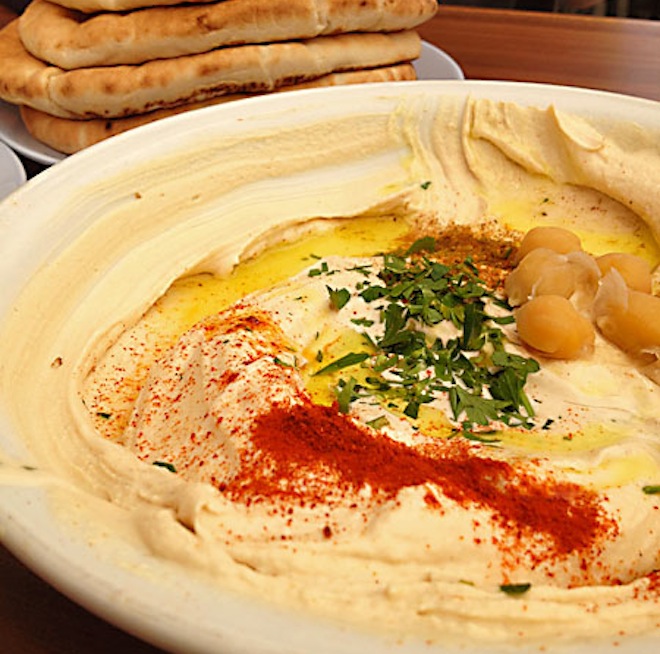
Photo: Rae Steinbach
My personal favorite (so I made it no. 1), hummus is a dip made of a basic base of chickpeas, tahini and garlic all blended together until smooth and creamy. Found in the mezze/appetizer section in basically all Middle Eastern restaurants and just generally everywhere in the Middle East, hummus is a staple dish that can be eaten plain with some fresh pita or added to other dishes to act like a condiment. Easy to make and healthy, too; basic recipe here.
2. Shawarma
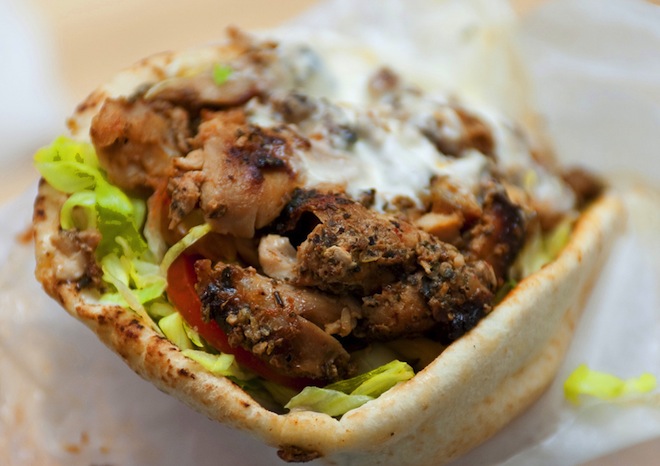
Photo Courtesy of pita-falafel.com
Any kid who did Birthright will tell you there are two food options in seemingly all of Israel: falafel and shawarma. It’s what we were told to eat, what was always available and yep, is really, ridiculously tasty.
Like a Greek gyro, but with more easily identifiable meat, the meat is slow-roasted on a turning spit, lending juiciness and tenderness. Added is a tangy blend of spices that mingles with the smoky and meaty flavor, which once wrapped up in a laffa with some veggies and sauce creates a little bundle of goodness. Chicken and beef are the most widely available in the U.S., but keep an eye out for lamb, which is a more traditional specialty.
3. Tabbouleh
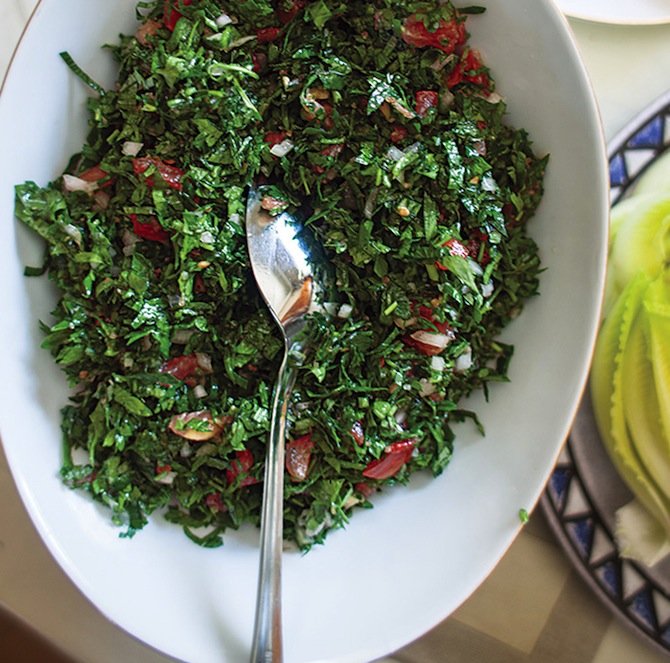
Photo Courtesy of SAVEUR Magazine
Have some floss on hand for this next dish because it is basically a guarantee you will have something green stuck between your teeth.
Chock full of green herbs, tomatoes and bulgur (aka cracked wheat), tabbouleh is a refreshing side dish full of bold flavor. So when you’re feeling leaden after the shawarma sandwich with a side of falafel (talking to you, Birthrighters), seek out this bright and healthful salad or make it at home. Just remember to direct those chompers at a mirror when you’re done.
4. Soup-e Adas (Lentil Soup)
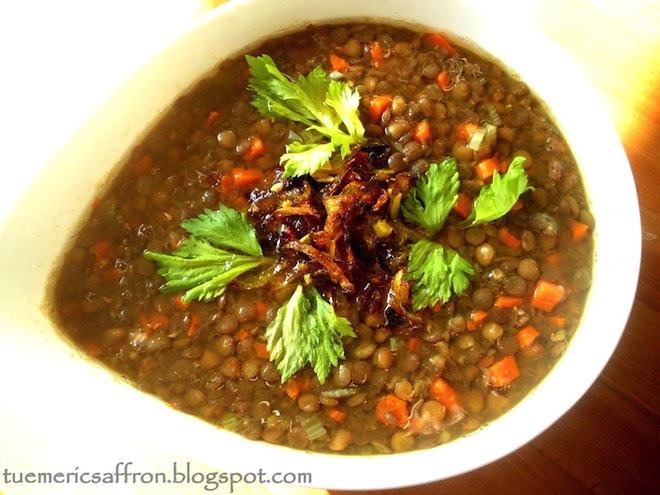
Photo: Azita Mehran
A warm and hearty soup is one of the basic appetizers of any Middle Eastern meal. With lentils being a popular and versatile ingredient in the cuisine, it makes sense to make them the star of this vegetarian comfort food dish. Grab a bowl courtesy of Azita’s Turmeric & Saffron blog as we head into the frigid months.
5. Baklava

Photo: Rae Steinbach
It’s time for a sweet moment, courtesy of this flaky, indulgently sweet pastry known as baklava (note: this is a very different thing than a balaclava).
Thin sheets of phyllo dough are layered between a filling usually made from a type of nut that’s coarsely ground and mixed with honey, sugar and spices. It’s topped off with a drizzling of sticky, sweet syrup as the finishing touch to a unique dessert.
Pistachio and walnut baklava is common, but fillings can also be fruity or other flavors. Look out for fun shapes, too: baklava comes in cylinders, birds’ nests and triangle shapes among other varieties. What could be bad when this much butter and sugar is involved?
6. Baba Ghanouj (Baba Ghanoush)
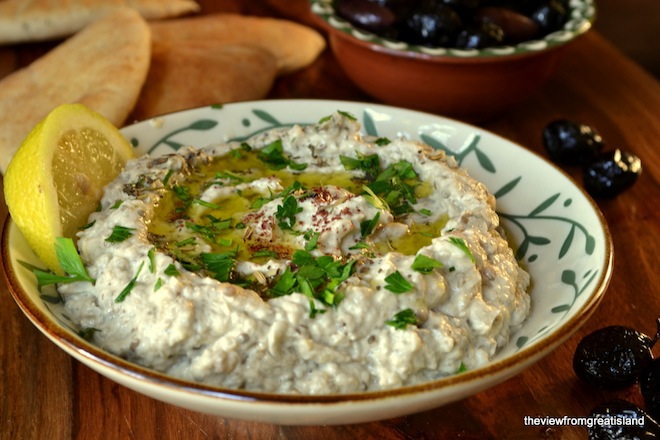
Photo Courtesy of The View from Great Island
Like many of the other Middle Eastern foods, the spelling of this succulent eggplant dip has a million variations. Regardless of how it’s spelled, however, the basic composition, though, remains the same across the Middle Eastern region: roasted eggplant, tahini, garlic and spices.
Usually found in the same mezze platter as hummus, it’s one of the many delicious spreads that comprises the backbone of Middle Eastern cuisine. Try making some at home – it’s easy, healthy and totally fulfills the snacking craving.
7. Shakshouka
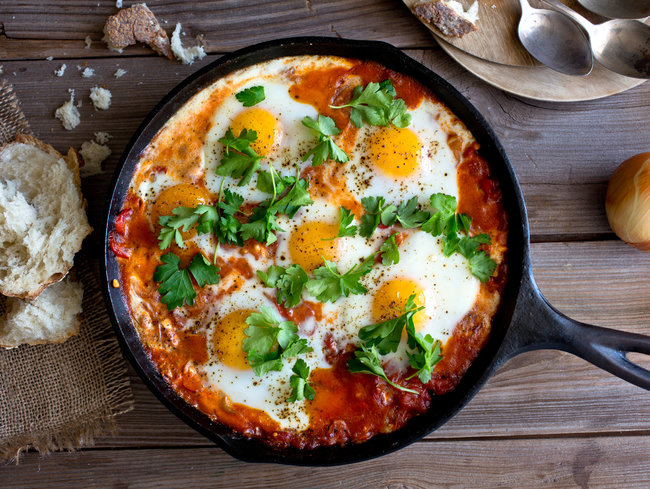
Photo Courtesy of nytimes.com
If you haven’t become aware of what shakshouka is in this day and age of the Mediterranean Diet, get ready. Nothing screams comfort food more than one-pot skillet dishes and shakshouka fits right in.
Tomatoes make up the majority of this dish, and they’re simmered slowly with herbs and spices before having eggs cracked right over the top and cooked with the heat. What results is a comfort strew of sorts, with softly cooked eggs in a spiced (and sometimes, spicy) tomato sauce. With some hearty bread for dipping, shakshouka hits every note of comfort you need in your life, always. Delicious for breakfast, lunch and dinner, try out an authentic Spoon U recipe here.
8. Mejadra
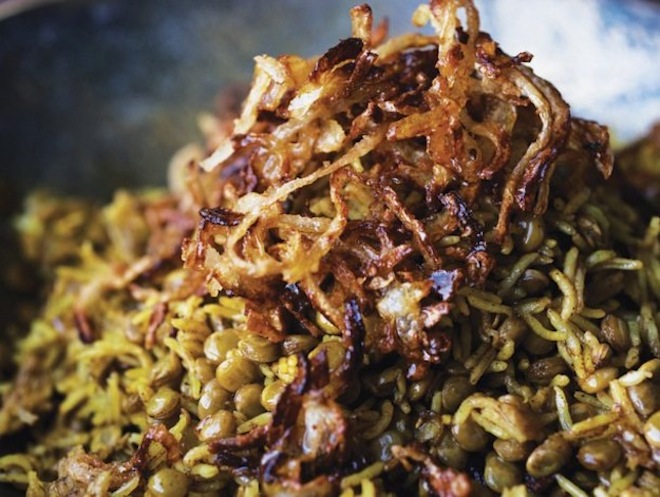
Photo Courtesy of Serious Eats
Another comfort food favorite, mejadra (also spelled mujaddara) is the pilaf of your dreams. You may not think pilaf is in your dreams, but it is and this is the stuff it’s made of. Lentils and riced are cooked together with a combination of spices that includes a heavy dose of cumin. The fragrant mixture is then topped off with crispy, fried onions, which provide the perfect crunchy contrast to the soft rice and lentil blend. A steaming hot bowl of this will save any chilly winter night.
9. Sabich
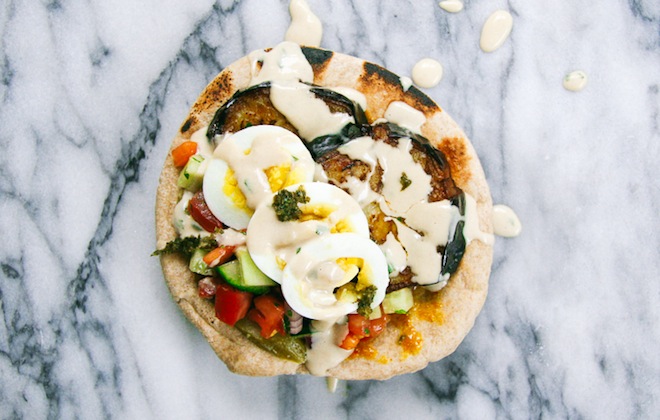
Photo: I Will Not Eat Oysters blog
When you just can’t stomach one more falafel (if ever that day comes) or want to try an alternative pita-stuffed concoction, sabich is the dish for you. Fried eggplant is combined with a hard-boiled egg and vegetables, stuffed into a pita and doused with tahini.
Sure, the combination sounds like one of your more stranger drunchies (and it does make for an excellent drunchie, by the way), but it’s actually just as amazingly delicious sober. Unusual, maybe, but the combination of decadent fried eggplant, smooth egg, fresh veggies and nutty tahini sauce is a fusion that works.
Found as a ubiquitous street food throughout the Middle East, it’s a little harder to come by in the U.S., but nowhere near impossible and definitely worth the search.
10. Böreks (Bourekas)
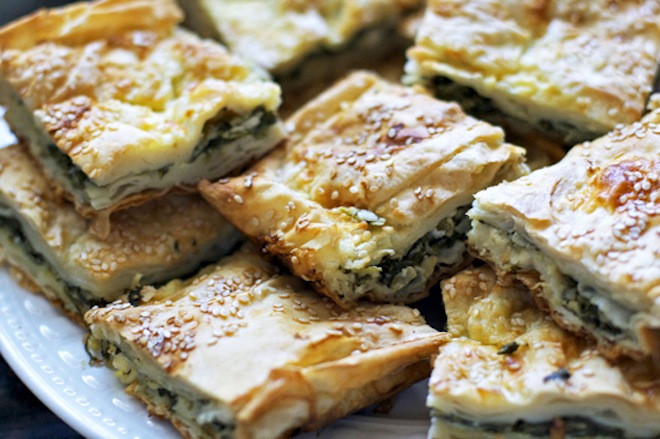
Photo: AZ Cookbook blog
Called böreks in Turkish cuisine and bourekas in Israel, these phyllo dough savory pastries have a variety of fillings. The Turkish variety is often filled with a spinach and cheese mixtures, like these ones pictured.
Meat is another common filling, however, making it a more substantial snack.
The Israeli boureka is more often filled with just cheese, but some varieties also hold a meat filling. They’re usually sold in Middle Eastern bakeries and are perfect as a satisfying snack on the go.
11. Halvah
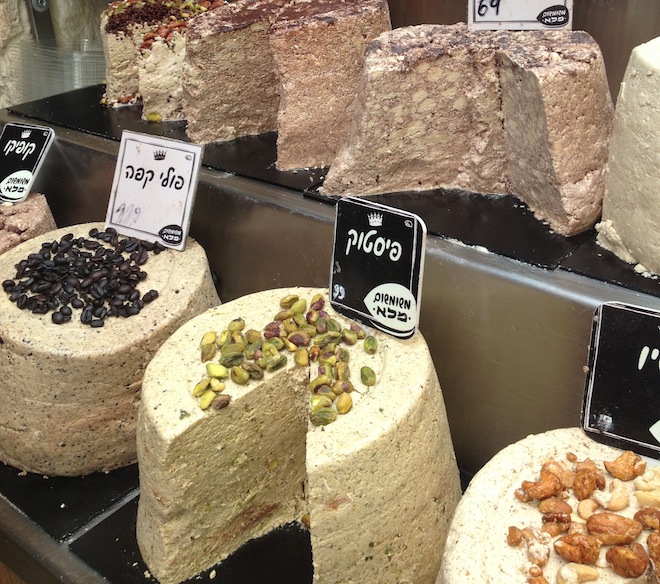
Photo: Rae Steinbach
Deceivingly the same shape as a cheese wheel or height-defying layer cake, these huge hunks are actually halvah. Halvah is a Middle Eastern sweet made from ground sesame seeds and sugar, often with added flavors like pistachio or chocolate. It’s incredibly unique in flavor, with an almost savory nuttiness that is cut with the addition of sweetener.
If you’ve ever had tahini, this stuff is made from the same base: sesame seeds. If you love it, you can’t get enough, but halvah definitely has divisive powers. Try it out and see on which side you fall.
12. Pita with Za’atar
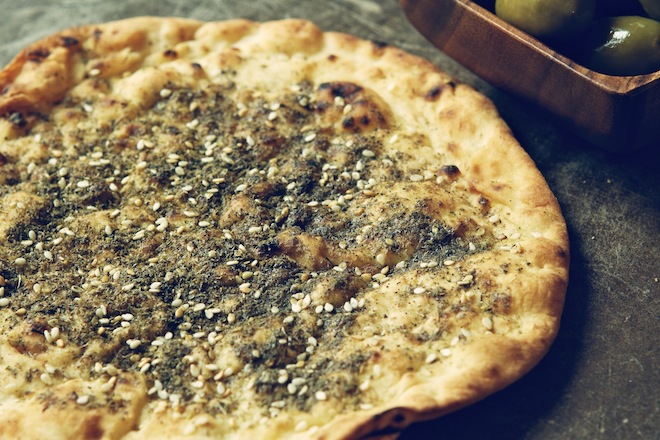
Photo: Matthew Lundin
Okay, so this isn’t exactly a dish on its own, but za’atar pita is way too tasty to leave off this list. Za’atar is a Middle Eastern spice blend that includes oregano, thyme and marjoram, but can also refer to the original plant that has since become government-protected due to its endangerment.
It has a distinct and savory flavor and is used in a variety of Middle Eastern dishes, though applying a liberal dusting of it to any bread product is equally satisfying. Pick up a jar of it at your local specialty foods store or ethnic supermarket and try making these za’atar pita crisps.
13. Labneh
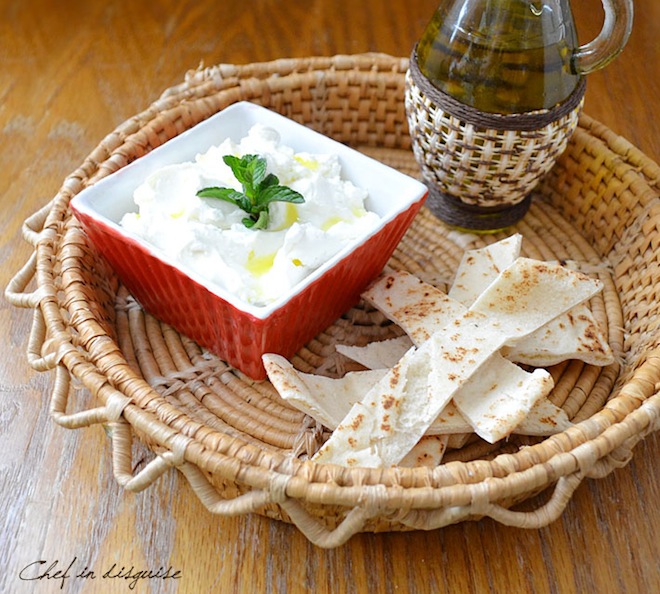
Photo Courtesy of Chef in Disguise
A thicker-than-the-thickest Greek yogurt type of cheese, labneh is another mezze staple. It’s not too strong or sour in flavor, rather reminiscent of cream cheese. Its texture, however, is incredibly thick and creamy, usually with a cow’s milk base.
Get inspired by the previous item on this list and dip some za’atar pita right into it or just sprinkle the spice directly on the labneh. It’s a versatile dip that adds another flavor to the mezze spread and, get this, is also apparently easy to make. Gotta love the labneh.
14. Falafel

Photo Courtesy of Food People Want
And here it is, one of the most widely recognized and beloved Middle Eastern foods: the falafel sandwich. Ground chickpeas are blended with herbs and spices before being formed into patties and fried. Falafel is at its best fresh out of the fryer, when the crunchy exterior contrasts with a light and fluffy inside; no one likes a cold falafel hockey puck.
Traditionally, a falafel sandwich is an over-stuffed pita masterpiece that includes tangy pickles, fresh vegetables and tahini sauce. Falafel places are popping up everywhere these days so go and grab yourself a fresh falafel sandwich (may I suggest with a side of hummus) and prepare yourself for a meal of magnificence.
In the mood for more Middle Eastern fare? We can help with that:
- 8 Middle Eastern Pastries You’ve Never Heard Of (And Need to Try)
- NYC’s Halal Guys Are Going International
- What the frick is “Freekeh?”

